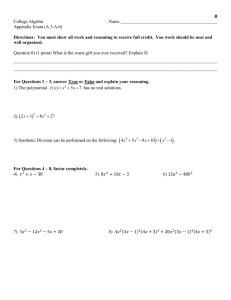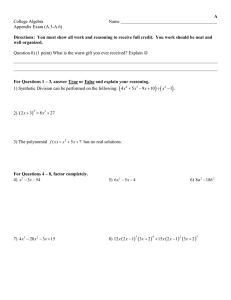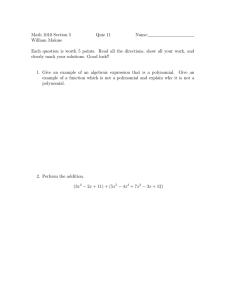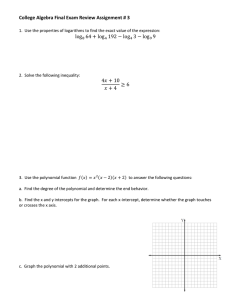Lagrange’s Interpolation Daniel Rogers ()
advertisement
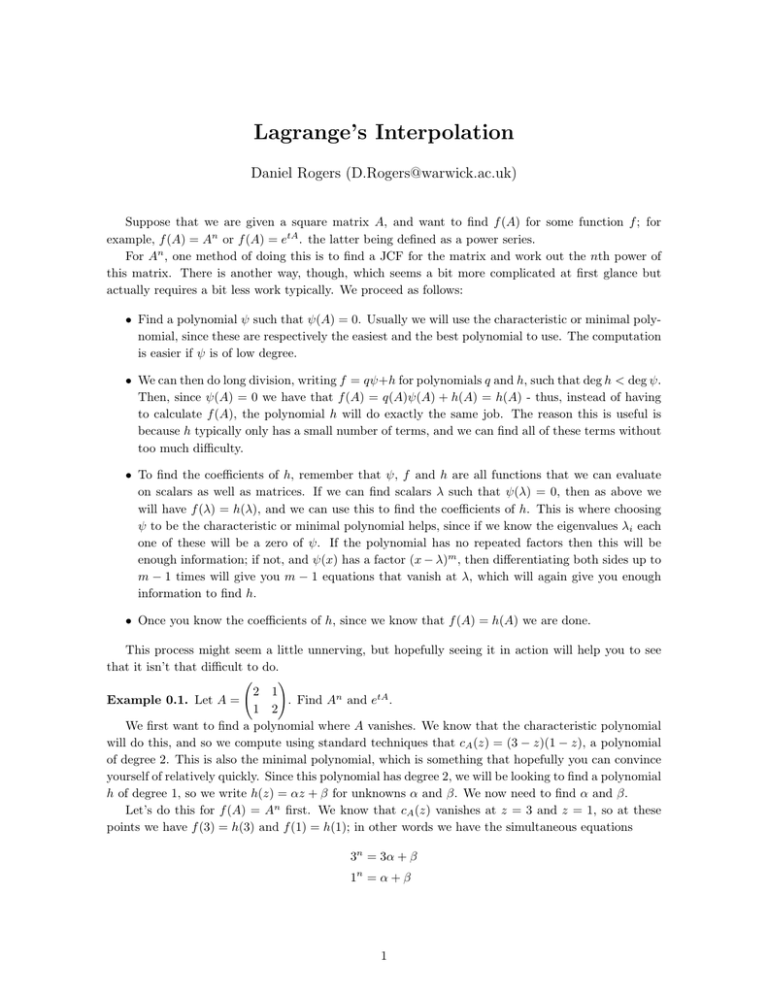
Lagrange’s Interpolation Daniel Rogers (D.Rogers@warwick.ac.uk) Suppose that we are given a square matrix A, and want to find f (A) for some function f ; for example, f (A) = An or f (A) = etA . the latter being defined as a power series. For An , one method of doing this is to find a JCF for the matrix and work out the nth power of this matrix. There is another way, though, which seems a bit more complicated at first glance but actually requires a bit less work typically. We proceed as follows: • Find a polynomial ψ such that ψ(A) = 0. Usually we will use the characteristic or minimal polynomial, since these are respectively the easiest and the best polynomial to use. The computation is easier if ψ is of low degree. • We can then do long division, writing f = qψ+h for polynomials q and h, such that deg h < deg ψ. Then, since ψ(A) = 0 we have that f (A) = q(A)ψ(A) + h(A) = h(A) - thus, instead of having to calculate f (A), the polynomial h will do exactly the same job. The reason this is useful is because h typically only has a small number of terms, and we can find all of these terms without too much difficulty. • To find the coefficients of h, remember that ψ, f and h are all functions that we can evaluate on scalars as well as matrices. If we can find scalars λ such that ψ(λ) = 0, then as above we will have f (λ) = h(λ), and we can use this to find the coefficients of h. This is where choosing ψ to be the characteristic or minimal polynomial helps, since if we know the eigenvalues λi each one of these will be a zero of ψ. If the polynomial has no repeated factors then this will be enough information; if not, and ψ(x) has a factor (x − λ)m , then differentiating both sides up to m − 1 times will give you m − 1 equations that vanish at λ, which will again give you enough information to find h. • Once you know the coefficients of h, since we know that f (A) = h(A) we are done. This process might seem a little unnerving, but hopefully seeing it in action will help you to see that it isn’t that difficult to do. ! 2 1 Example 0.1. Let A = . Find An and etA . 1 2 We first want to find a polynomial where A vanishes. We know that the characteristic polynomial will do this, and so we compute using standard techniques that cA (z) = (3 − z)(1 − z), a polynomial of degree 2. This is also the minimal polynomial, which is something that hopefully you can convince yourself of relatively quickly. Since this polynomial has degree 2, we will be looking to find a polynomial h of degree 1, so we write h(z) = αz + β for unknowns α and β. We now need to find α and β. Let’s do this for f (A) = An first. We know that cA (z) vanishes at z = 3 and z = 1, so at these points we have f (3) = h(3) and f (1) = h(1); in other words we have the simultaneous equations 3n = 3α + β 1n = α + β 1 n n Solving these equations is hopefully straightforward, and gives you α = 3 2−1 , β = 3−3 2 . The interesting part is that now, we have all the information we need to complete the question now ! n A = f (A) = h(A) = αA + βI2 = 3n +1 2 3n −1 2 3n −1 2 3n +1 2 . A good check to make sure that you haven’t gone wrong somewhere in putting everything together is to try n = 0 (which should give you the identity matrix), n = 1 (which should give you A), and if you’re feeling keen, you could test n = 2 and compute A2 . If any of these don’t give you the same result it is worth checking your calculations. We can do the same process for f (A) = etA , only now the simultaneous equations become e3t = 3α + β et = α + β We solve and proceed exactly as before (I’m omitting the detail here but when you’re doing the problem sheets you shouldn’t) to get ! e tA = e3t +et 2 e3t −et 2 e3t −et 2 e3t +et 2 . One of the reasons these matrices are useful is to solve various sets of equations. For instance, suppose we now have to solve the recurrence relation given by x0 = 0, y0 = −1 and in general xn = 2xn−1 + yn−1 yn = xn−1 + 2yn−1 Hopefully it should be clear that we can use the computation of An that we did above, as we have ! ! ! xn x 0 0 = An = An yn y0 −1 n n −1−3 . which quickly gives us that xn = 1−3 2 , yn = 2 A similar process is described in the lecture notes for solving some differential equations using the operator etA , and this is something you are asked to do on Sheet 2. The other main concept discussed on Sheet 2 are the notions of bilinear maps and quadratic forms, but most of what I was planning to say in the supervision would be going over the material in the lecture notes again. If you have any general questions (i.e. not of the form ”How do I do question n on the sheet?”) regarding these (or anything else in this handout) do let me know. 2

